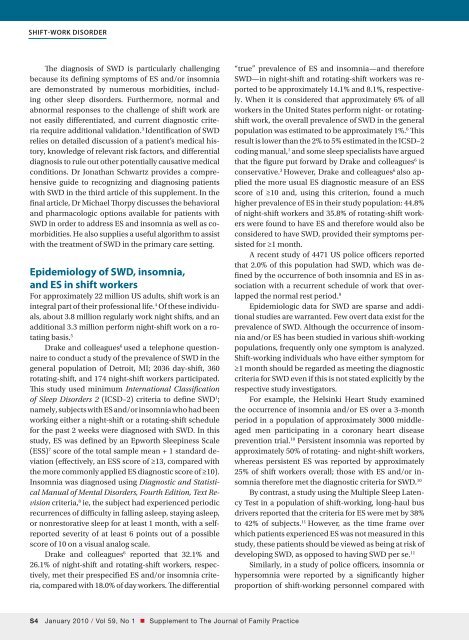Shift-work disorder - myCME.com
Shift-work disorder - myCME.com
Shift-work disorder - myCME.com
Create successful ePaper yourself
Turn your PDF publications into a flip-book with our unique Google optimized e-Paper software.
<strong>Shift</strong>-<strong>work</strong> <strong>disorder</strong><br />
The diagnosis of SWD is particularly challenging<br />
because its defining symptoms of ES and/or insomnia<br />
are demonstrated by numerous morbidities, including<br />
other sleep <strong>disorder</strong>s. Furthermore, normal and<br />
abnormal responses to the challenge of shift <strong>work</strong> are<br />
not easily differentiated, and current diagnostic criteria<br />
require additional validation. 3 Identification of SWD<br />
relies on detailed discussion of a patient’s medical history,<br />
knowledge of relevant risk factors, and differential<br />
diagnosis to rule out other potentially causative medical<br />
conditions. Dr Jonathan Schwartz provides a <strong>com</strong>prehensive<br />
guide to recognizing and diagnosing patients<br />
with SWD in the third article of this supplement. In the<br />
final article, Dr Michael Thorpy discusses the behavioral<br />
and pharmacologic options available for patients with<br />
SWD in order to address ES and insomnia as well as <strong>com</strong>orbidities.<br />
He also supplies a useful algorithm to assist<br />
with the treatment of SWD in the primary care setting.<br />
Epidemiology of SWD, insomnia,<br />
and ES in shift <strong>work</strong>ers<br />
For approximately 22 million US adults, shift <strong>work</strong> is an<br />
integral part of their professional life. 4 Of these individuals,<br />
about 3.8 million regularly <strong>work</strong> night shifts, and an<br />
additional 3.3 million perform night-shift <strong>work</strong> on a rotating<br />
basis. 5<br />
Drake and colleagues 6 used a telephone questionnaire<br />
to conduct a study of the prevalence of SWD in the<br />
general population of Detroit, MI; 2036 day-shift, 360<br />
rotating-shift, and 174 night-shift <strong>work</strong>ers participated.<br />
This study used minimum International Classification<br />
of Sleep Disorders 2 (ICSD–2) criteria to define SWD 1 ;<br />
namely, subjects with ES and/or insomnia who had been<br />
<strong>work</strong>ing either a night-shift or a rotating-shift schedule<br />
for the past 2 weeks were diagnosed with SWD. In this<br />
study, ES was defined by an Epworth Sleepiness Scale<br />
(ESS) 7 score of the total sample mean + 1 standard deviation<br />
(effectively, an ESS score of ≥13, <strong>com</strong>pared with<br />
the more <strong>com</strong>monly applied ES diagnostic score of ≥10).<br />
Insomnia was diagnosed using Diagnostic and Statistical<br />
Manual of Mental Disorders, Fourth Edition, Text Revision<br />
criteria, 8 ie, the subject had experienced periodic<br />
recurrences of difficulty in falling asleep, staying asleep,<br />
or nonrestorative sleep for at least 1 month, with a selfreported<br />
severity of at least 6 points out of a possible<br />
score of 10 on a visual analog scale.<br />
Drake and colleagues 6 reported that 32.1% and<br />
26.1% of night-shift and rotating-shift <strong>work</strong>ers, respectively,<br />
met their prespecified ES and/or insomnia criteria,<br />
<strong>com</strong>pared with 18.0% of day <strong>work</strong>ers. The differential<br />
“true” prevalence of ES and insomnia—and therefore<br />
SWD—in night-shift and rotating-shift <strong>work</strong>ers was reported<br />
to be approximately 14.1% and 8.1%, respectively.<br />
When it is considered that approximately 6% of all<br />
<strong>work</strong>ers in the United States perform night- or rotatingshift<br />
<strong>work</strong>, the overall prevalence of SWD in the general<br />
population was estimated to be approximately 1%. 6 This<br />
result is lower than the 2% to 5% estimated in the ICSD–2<br />
coding manual, 1 and some sleep specialists have argued<br />
that the figure put forward by Drake and colleagues 6 is<br />
conservative. 3 However, Drake and colleagues 6 also applied<br />
the more usual ES diagnostic measure of an ESS<br />
score of ≥10 and, using this criterion, found a much<br />
higher prevalence of ES in their study population: 44.8%<br />
of night-shift <strong>work</strong>ers and 35.8% of rotating-shift <strong>work</strong>ers<br />
were found to have ES and therefore would also be<br />
considered to have SWD, provided their symptoms persisted<br />
for ≥1 month.<br />
A recent study of 4471 US police officers reported<br />
that 2.0% of this population had SWD, which was defined<br />
by the occurrence of both insomnia and ES in association<br />
with a recurrent schedule of <strong>work</strong> that overlapped<br />
the normal rest period. 9<br />
Epidemiologic data for SWD are sparse and additional<br />
studies are warranted. Few overt data exist for the<br />
prevalence of SWD. Although the occurrence of insomnia<br />
and/or ES has been studied in various shift-<strong>work</strong>ing<br />
populations, frequently only one symptom is analyzed.<br />
<strong>Shift</strong>-<strong>work</strong>ing individuals who have either symptom for<br />
≥1 month should be regarded as meeting the diagnostic<br />
criteria for SWD even if this is not stated explicitly by the<br />
respective study investigators.<br />
For example, the Helsinki Heart Study examined<br />
the occurrence of insomnia and/or ES over a 3-month<br />
period in a population of approximately 3000 middleaged<br />
men participating in a coronary heart disease<br />
prevention trial. 10 Persistent insomnia was reported by<br />
approximately 50% of rotating- and night-shift <strong>work</strong>ers,<br />
whereas persistent ES was reported by approximately<br />
25% of shift <strong>work</strong>ers overall; those with ES and/or insomnia<br />
therefore met the diagnostic criteria for SWD. 10<br />
By contrast, a study using the Multiple Sleep Latency<br />
Test in a population of shift-<strong>work</strong>ing, long-haul bus<br />
drivers reported that the criteria for ES were met by 38%<br />
to 42% of subjects. 11 However, as the time frame over<br />
which patients experienced ES was not measured in this<br />
study, these patients should be viewed as being at risk of<br />
developing SWD, as opposed to having SWD per se. 11<br />
Similarly, in a study of police officers, insomnia or<br />
hypersomnia were reported by a significantly higher<br />
proportion of shift-<strong>work</strong>ing personnel <strong>com</strong>pared with<br />
S January 2010 / Vol 59, No 1 • Supplement to The Journal of Family Practice
















